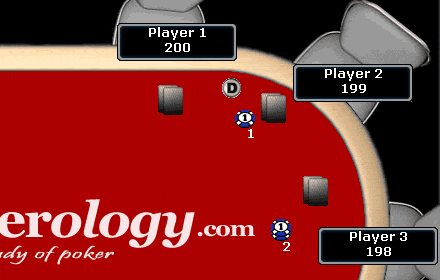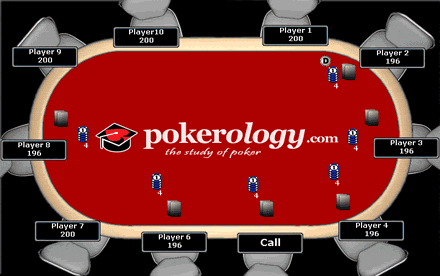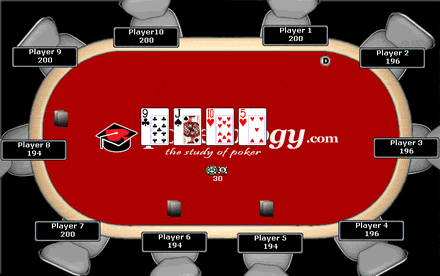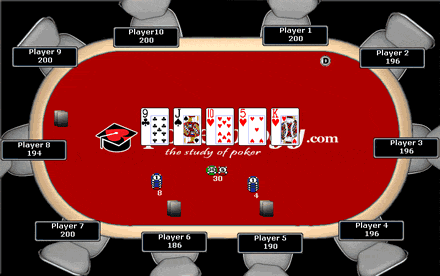
The Basic Rules of Texas Hold’em Poker
Poker comes in many variations—Seven Card Stud, Omaha, Five-Card Draw, and the globally popular Texas Hold’em.
As the most dominant version, Texas Hold’em is ideal for mastering poker fundamentals. In this guide, we’ll explain the basic rules of poker step by step, using a sample hand to illustrate each stage of play.
From dealing cards to final bets, you’ll learn core strategies, hand rankings, and essential gameplay concepts to build a strong foundation in poker.
The Setup
The game of hold’em is typically played with nine or ten players at the table.
Figure 1

In our example we have ten players. The dealer button is on player 1, the blinds have been posted, and each player has received their hole cards. If this doesn’t make sense to you, then don’t worry we’ll explain exactly what this all means.
The Dealer Button
The dealer button is the round disc labelled with “Dealer” or “D”, and it signifies who is the dealer for the hand. Please be aware that each player gets to ‘act’ as the dealer, even if they don’t physically deal the cards. After each hand the dealer button moves to the next player, in a clockwise manner. In figure 1, the dealer button is with player 1, but for the next hand it’ll be with player 2, and then player 3, and so on.
The dealer position is also called “the button” and is the most favourable position in the game as that player gets to act last after he has seen everyone else make their decisions. The exception to this rule occurs on the very first round of betting wherein the “blinds” will act after the button.
Blind Bets
Before any cards are dealt the two players to the left of the dealer button are required to post what are referred to as the blinds. These are forced and compulsory bets that encourage the action and give players something to shoot for. Typically there is a small blind directly to the left of the button, who posts half the size of the big blind’s obligation. The amount of the blinds is determined by the stakes of the game.
Figure 2

In our example we’re using blinds of $1 and $2. In case it’s not obvious, they are called blind bets because the two players are required to post them before they see their cards.
The Deal
Once the blinds have been posted each player is dealt two facedown cards, which are often referred to as their hole cards. The best two hole cards a player can be dealt in hold’em are two Aces’, but we’ll discuss the importance of starting hand selection in later lessons. All you need to know for now is that after the blinds have been posted and the hole cards have been dealt, the betting action can begin.
Pre-Flop
The first betting round in poker is called the pre-flop. It starts with the player to the left of the big blind, who can call, raise, or fold. Action moves clockwise around the table, giving each player the same options.
If everyone just calls, the small blind can add enough to match the big blind or raise. The big blind then gets the final move — they can check or raise since their bet is “live.” Once all bets are equal, the pre-flop round ends, and play moves to the flop.
If someone raises, every remaining player must either call the new bet, re-raise, or fold.
Figure 3

In our example player 6 raised the betting to $4, player 7 folded and is now out of the hand. Player 8 called, but players 9, 10, and 1 all folded and are also out of this hand. Players 2, 3, 4, and 5, all called player 6’s raise. Once all bets have been equalized (i.e. matched), then the betting round is over. In our example, six players are now left in and the pot contains $24 ($4 x 6). This brings us onto the next betting round, called the flop.
The Flop
After the first round of betting is complete three community cards are dealt face up in the middle of the table. All the active players can use these three cards, along with their two hole cards, to make their best possible hand. These three cards are known as “the flop”. Here’s the flop before any further betting has taken place:
Figure 4

After the pre-flop round, all bets go into the central pot, and the flop is dealt. A new betting round begins with the first active player to the left of the dealer (usually the small blind).
There are no forced bets now — players can check (pass without betting) or bet. Once someone bets, others must call, raise, or fold. The round continues until all bets are equal or everyone checks.
In the example, players 2–5 check, player 6 bets $2, player 8 calls, and players 2–4 fold. Players 5, 6, and 8 move on to the next stage — the turn.
The Turn
After the second round of betting (the flop) a fourth card is dealt and that card is called “the turn” – it’s also sometimes referred to as 4th street. In our example hand we have three players remaining:
Figure 5

At this stage, the pot has grown to $30—built from $24 in the opening betting round and $6 added on the flop. Once the fourth community card, known as the turn, is revealed, another betting round begins.
The structure mirrors the previous one, starting with the first active player seated left of the dealer button. In this example, that position belongs to player 5.
They can choose to check or place a bet. If player 5 checks and players 6 and 8 follow suit, the betting round ends without action, and play advances to the final stage—the river.
The River
After the third round of betting is complete the fifth and final board card is dealt and that card is called “the river” – it’s also sometimes referred to as 5th street.
Figure 6

In our example hand, there is $30 in the pot and player 5 bets $4. He’s raised by player 6 (who makes it $8 total). Let’s suppose that player 8 folds, and player 5 decides to call the extra $4. When the final betting round ends with two or more active players (as our example has done), then we get to what is called a “showdown”.
The Showdown
After the final betting round is completed, it’s time to see who has won the hand, and the money in the pot. Now that all of the cards have been dealt, each player can combine his two hole cards with any of the five cards on the board to create his best five card poker hand. The winning hand must been seen, which means players can now reveal their two hole cards. The player that was called (player 6) is required to show first. Figure 7 shows an example showdown after both players have shown their hole cards:
Figure 7

Which hand wins? Player 5 has a straight (9, T, J, Q, K), and player 6 has a higher straight (T, J, Q, K, A) but his best hand is a flush (A, K, Q, T, 5 of hearts). If you studied the poker hand rankings lesson then you will be aware that a flush always beats a straight. Therefore player 6 wins this hand, and as you can see in figure 6, after the final betting on the river, the pot now contains $46. Player 6 wins the pot of $46, and a new hand can begin.
Some Important Points…
As noted earlier, not every poker hand makes it to a showdown. In fact, many end before the flop is even revealed. While our sample hand played through to the river, a player can claim victory at any betting stage if their wager goes uncalled.
In these spots, the pot is awarded uncontested—similar to a boxer winning with a first-round knockout rather than a long decision.
Equally important is understanding that in a showdown, you don’t need to use both hole cards. The winning hand is always the best five-card combination available, even if that means relying solely on the community cards.
For example, if the board produces a Royal Flush, every player still in the hand splits the pot evenly, regardless of their private holdings. Though each player sees seven total cards—two hole cards plus five community cards—only the strongest five decide the winner.
Of course there are many other rules and important concepts you need to understand, but hopefully you’ve learnt a lot from this lesson. The game of Texas hold’em is a deceptively simple game, but as you move through the myriad of poker lessons here on Pokerlogy you will experience an astounding wealth of information and strategy.